Opals are a unique and mesmerizing gemstone known for their distinctive play of color, making them one of the most sought-after and mysterious gemstones in the world. In this introduction, we will provide a definition and a brief overview of opals.


Definition: Opals are a type of mineraloid, which means they lack the crystalline structure of typical minerals. Instead, opals are composed of tiny spheres of silica, often arranged in a closely packed and orderly manner. What sets opals apart from other gemstones is their remarkable play of color, which is a phenomenon known as “opalescence.” This play of color occurs due to the interaction of light with the silica spheres within the opal, causing the gemstone to exhibit a stunning array of iridescent colors, often resembling a vibrant spectrum of hues.
Name: Known since antiquity, derives its name from the Roman word opalus, which means “precious stone.”
Association: Chalcedony, quartz, calcite, topaz, goethite, cinnabar, phillipsite, magnesite, fluorite, ikaite
Polymorphism & Series: The structure of low-pressure polymorphs of anhydrous silica consist of frameworks of fully corner bonded tetrahedra of SiO4. The higher temperature polymorphs of silica cristobalite and tridymite are frequently the first to crystallize from amorphous anhydrous silica, and the local structures of microcrystalline also appear to be closer to that of cristobalite and tridymite than to quartz. The structures of tridymite and cristobalite are closely related and can be described as hexagonal and cubic close-packed layers. It is therefore possible to have intermediate structures in which the layers are not regularly stacked.
Historical Significance
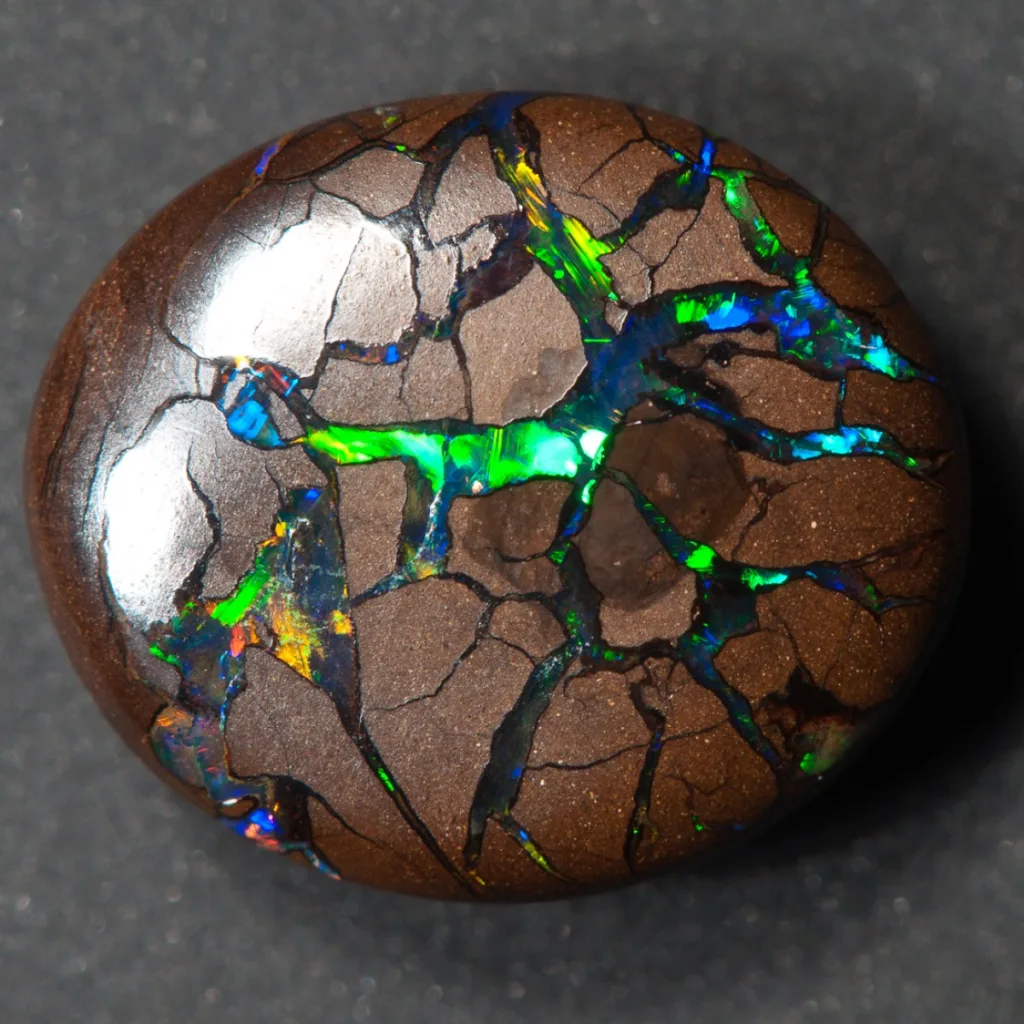
Opals have a rich historical significance and cultural importance in various societies throughout history. Their unique play of color and captivating appearance have led to a range of symbolic meanings and beliefs associated with these gemstones. Here’s a closer look at the cultural and symbolic importance of opals:
1. Ancient Roman and Greek Beliefs: In ancient Rome and Greece, opals were highly regarded and believed to be symbols of hope and purity. The Romans called opals “opalus,” meaning “precious stone,” and considered them a symbol of love and good fortune. They associated opals with the rainbow and believed that the gemstones possessed the colors of all other precious stones.
2. Middle Eastern Beliefs: In the Middle East, opals were believed to have fallen from the heavens in lightning storms, making them highly prized and revered. Arabic legends suggested that opals held lightning and had the power to protect against evil.
3. Australian Aboriginal Culture: Opals hold immense cultural significance to Australia’s Indigenous communities, particularly to the Australian Aboriginal people. They have various Dreamtime stories and legends associated with opals, which often involve the creator being associated with the gemstone. Opals are considered sacred, and their colors are believed to represent different spiritual elements.
4. Superstitions and Myths: Opals have been both celebrated and feared for their unique play of color. In some cultures, they were considered symbols of good luck and protection, while in others, they were associated with bad luck and superstitions. Some believed that opals carried curses or misfortune, possibly due to their fragile nature.
5. Birthstone and Zodiac Significance: Opal is the birthstone for October, and it is associated with the zodiac sign Libra. Many people believe that wearing opal jewelry during their birth month can bring them good luck and positive energy.
6. Modern Symbolism: Today, opals are often associated with creativity, inspiration, and emotional healing. They are believed to enhance one’s intuition and imagination. Opal jewelry is frequently given as a gift to symbolize love, loyalty, and hope.
7. Opals in Art and Literature: Opals have been featured prominently in art and literature, often as symbols of mystery and transformation. They have inspired countless poets, writers, and artists with their mesmerizing colors and unique beauty.
8. Royal and Historical Significance: Opals have been used in the crowns, jewelry, and regalia of royals and aristocrats throughout history. Their allure and rarity made them valuable possessions for monarchs and nobility.
In summary, opals have held diverse and evolving cultural and symbolic significance throughout history. While they have been revered for their captivating beauty and positive attributes in many cultures, they have also faced superstitions and myths in others. Today, opals continue to be cherished for their unique play of color and are celebrated as symbols of creativity, love, and hope in the modern world.
Opal Chemical, Physical and Optical Properties

Opals are unique gemstones with distinct chemical, physical, and optical properties that contribute to their characteristic play of color and overall appearance. Here’s an overview of these properties:
Chemical Properties:
- Composition: Opals are primarily composed of hydrated silicon dioxide (SiO2·nH2O), commonly known as silica. The water content in opals can vary, and it plays a crucial role in the gemstone’s optical properties.
- Amorphous Structure: Unlike many other gemstones, which have a crystalline structure, opals have an amorphous, non-crystalline structure. This lack of crystallinity is responsible for their unique optical properties.
Physical Properties:
- Hardness: Opals are relatively soft gemstones, with a hardness of about 5.5 to 6.5 on the Mohs scale. This means they are more susceptible to scratching and abrasion compared to harder gemstones like diamonds or sapphires.
- Specific Gravity: The specific gravity of opals typically ranges from 1.98 to 2.25. This value indicates the gemstone’s density relative to the density of water.
- Transparency: Opals can be translucent to semi-translucent, with varying degrees of transparency depending on their type and quality.
- Cleavage and Fracture: Opals do not have a distinct cleavage like some other minerals. They exhibit conchoidal fracture, which means they break with smooth, curved surfaces similar to the way glass shatters.
Optical Properties:
- Play of Color: The most distinctive optical property of opals is their play of color, also known as “opalescence.” This phenomenon results from the interaction of light with microscopic silica spheres or voids within the opal. The varying sizes and arrangement of these spheres cause diffraction and interference of light, producing a spectrum of vibrant colors that change as the viewing angle shifts.
- Body Color: Opals can have a range of body colors, including white, black, gray, and various shades of brown. The play of color is superimposed on this body color, creating the opal’s overall appearance.
- Luster: Opals typically exhibit a vitreous to resinous luster, but this can vary depending on the type and quality of the opal.
- Refractive Index: Opals have a refractive index that falls in the range of 1.37 to 1.47. This index affects the way light is bent or refracted as it passes through the gemstone, contributing to the play of color.
- Birefringence: Opals do not exhibit birefringence, unlike some other gemstones that split light into two distinct rays.
- Dispersion: While opals do not have the high dispersion seen in diamonds or other gemstones like sapphires, their play of color is a form of dispersion, where different colors are separated and displayed due to the varying wavelengths of light.
In summary, opals are characterized by their unique play of color, which is a result of their amorphous structure and the interaction of light with microscopic structures within the gemstone. These properties make opals one of the most intriguing and captivating gemstones in the world, prized for their iridescent and ever-changing beauty.
Occurrence and Formation of Opal
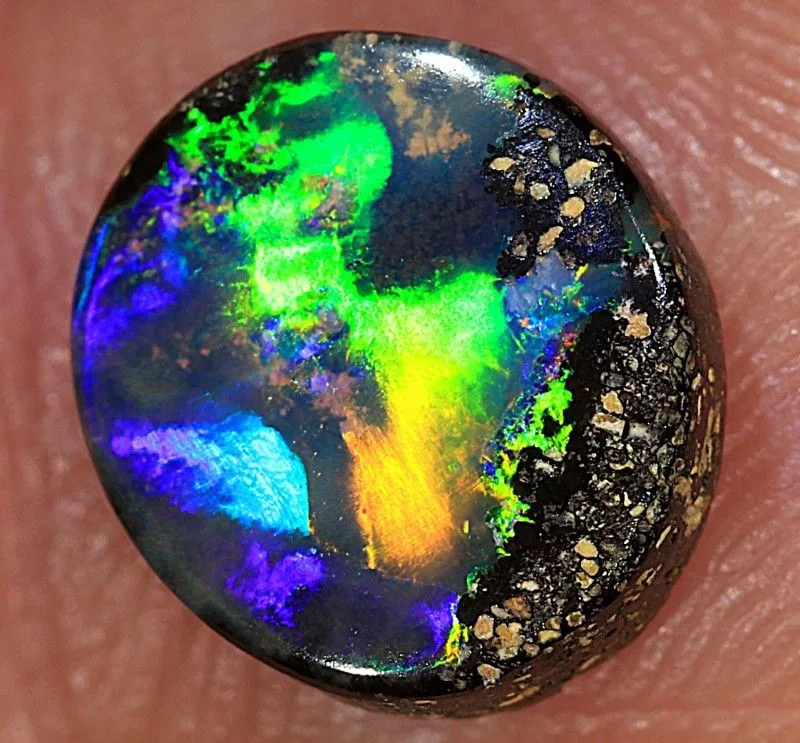
Opals are formed through intricate geological processes and are found in various parts of the world. Their occurrence and formation involve a combination of specific geological conditions and the deposition of silica-rich solutions. Here’s an overview of how opals occur and are formed:
1. Geological Conditions:
- Silica-Rich Environments: Opals are primarily composed of hydrated silica (SiO2·nH2O). They form in geological environments where silica-rich solutions are present. These solutions can come from a variety of sources, including groundwater, volcanic activity, and weathering of pre-existing rocks.
- Porosity: The host rocks or sediments where opals form often have a high degree of porosity. This allows for the infiltration and circulation of silica-rich fluids.
2. Formation Process:
- Hydration of Silica: Opal formation begins when water, often carrying dissolved silica, seeps into the host rock or sediment. The silica can come from the dissolution of surrounding minerals like quartz.
- Deposition: As the silica-rich water infiltrates the porous rock or sediment, it encounters various conditions that trigger the precipitation of opal. These conditions can include changes in temperature, pressure, or pH levels.
- Colloidal Silica: In some cases, opal formation involves the aggregation of tiny silica particles, creating a gel-like substance known as colloidal silica. This colloidal silica can accumulate in cracks, voids, or other openings within the host material.
- Drying and Hardening: Over time, as the water carrying silica infiltrates deeper into the host rock or sediment and begins to evaporate or lose water content, the silica solidifies and hardens. The precise conditions during this drying process, including the rate of evaporation and temperature, can influence the type of opal formed and its play of color.
3. Types of Opals:
- Precious Opals: These are opals that display the well-known play of color or opalescence. The play of color is a result of the unique arrangement of silica spheres within the opal, which diffract and scatter light, creating vibrant hues.
- Common Opals: Common opals do not exhibit a play of color. They are typically opaque to translucent and may have a single, uniform body color. While they lack the iridescence of precious opals, they can still be attractive and valuable.
4. Locations of Occurrence:
- Australia: Australia is renowned for producing some of the world’s most famous and valuable opals, including Black Opals, White Opals, and Boulder Opals. The Australian outback, particularly regions like Lightning Ridge, Coober Pedy, and Queensland, is known for its opal mines.
- Ethiopia: Ethiopia has become a significant source of opals in recent years, particularly Welo and Mezezo opals, which can exhibit vibrant play of color.
- Mexico, Brazil, and the United States: These countries also have opal deposits, with Mexico known for its Fire Opals and Brazil for its colorful Opalinas. In the United States, Nevada is a notable source of precious opals.
In conclusion, opals are formed through the deposition of silica-rich solutions in geological environments with specific conditions, resulting in the unique and mesmerizing gemstones known for their play of color. The occurrence of opals can vary widely, with different types and qualities found in different regions around the world.
Types of Opals
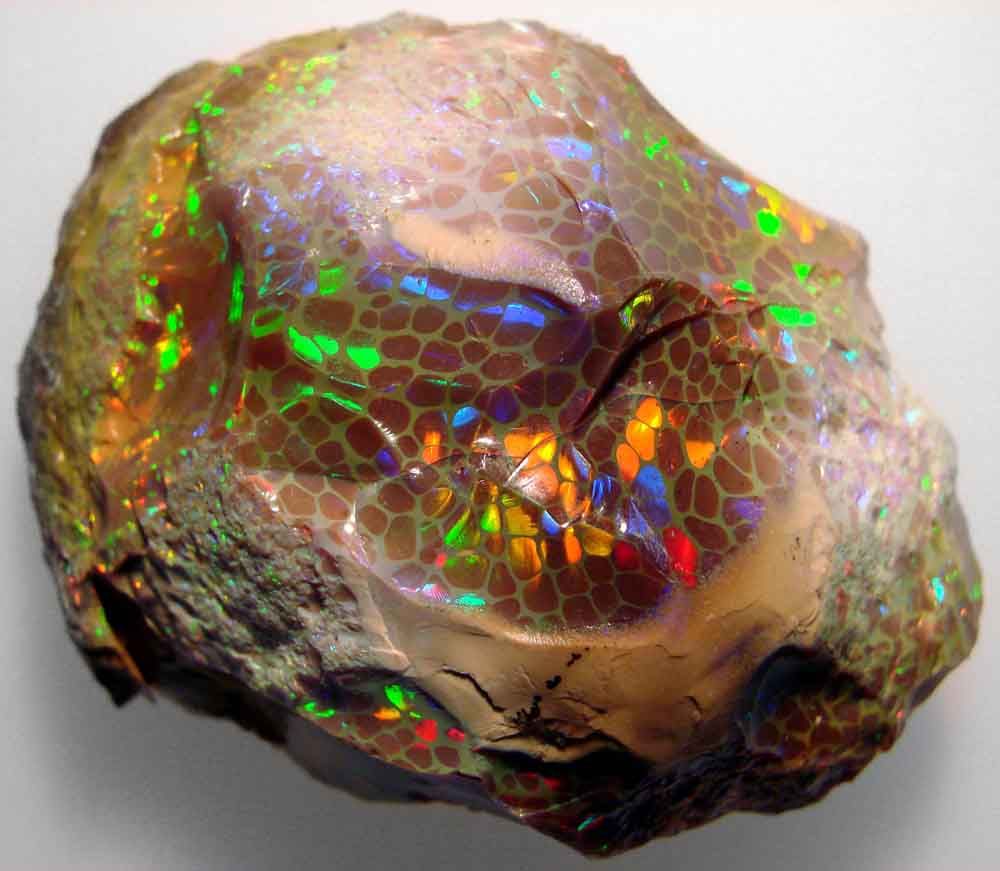
Opals come in various types, each with its own distinctive characteristics and appearance. The primary types of opals include:
- Precious Opals:
- White Opals: White opals are characterized by their white to light gray body color, and they often display a play of color with vibrant hues. These opals are usually found in South Australia and are valued for their subtle yet beautiful play of color.
- Black Opals: Black opals are the most highly prized and sought-after opals. They have a dark body color, typically black or very dark gray, which serves as a striking backdrop for their intense and vivid play of color. The town of Lightning Ridge in New South Wales, Australia, is renowned for producing some of the world’s finest black opals.
- Boulder Opals: Boulder opals form within ironstone matrix or host rock, and they often display a play of color against a natural brown or ironstone background. These opals are mainly found in Queensland, Australia. Boulder opals are unique because they retain some of the host rock, creating intriguing patterns and designs.
- Crystal Opals: Crystal opals have a transparent to translucent body, allowing for an excellent play of color to be visible. They can display vibrant colors against a clear or slightly milky background. Crystal opals are found in various opal-producing regions, including Australia and Brazil.
- Jelly Opals: Jelly opals are a subtype of crystal opals characterized by their transparent, jelly-like appearance. They often have a water-clear body that enhances the visibility of the play of color.
- Common Opals:
- White Common Opals: White common opals, as the name suggests, have a white or light-colored body without a significant play of color. They are known for their opalescence, which gives them a milky, semi-translucent appearance.
- Mexican Fire Opals: These opals are valued for their vibrant orange, red, or yellow body colors. They do not typically display a play of color but are prized for their intense, fiery hues. Mexico is a primary source of fire opals.
- Peruvian Opals: Found mainly in Peru, these opals come in various colors, including blue-green, pink, and purple. They are known for their smooth, cabochon-cut appearance and are often used in jewelry.
- Hydrophane Opals: Hydrophane opals have the unique property of becoming temporarily transparent or translucent when immersed in water. This property makes them popular for carving and cabochon cutting.
- Matrix Opals:
- Matrix opals are opals that are naturally embedded within their host rock, forming interesting patterns and designs. Boulder opals are a type of matrix opal, but there are other varieties as well, such as Koroit opal and Yowah opal, which are also found in Queensland, Australia.
- Synthetic Opals:
- Synthetic or lab-created opals are manufactured in laboratories to replicate the appearance of natural opals. While they may not have the geological origin of natural opals, they can exhibit a play of color and are used in jewelry.
Each type of opal has its unique beauty and appeal, making opals one of the most diverse and captivating gemstones in the world of jewelry and gem collecting.
Uses and Application of Opal
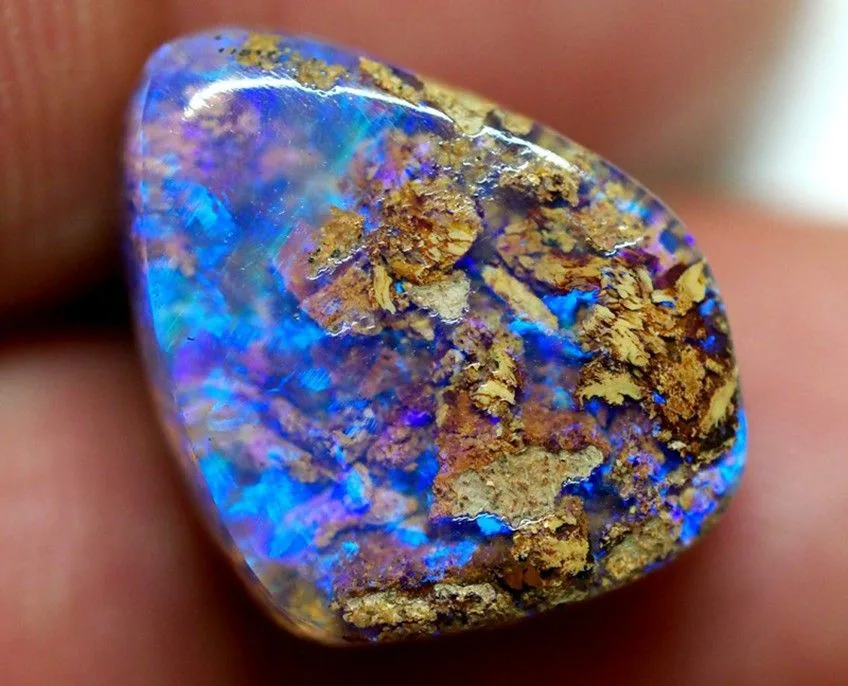
Opals are prized gemstones with a wide range of uses and applications, primarily in the realm of jewelry and ornamental items. Their unique play of color and enchanting appearance make them a popular choice for various purposes:
1. Jewelry:
- Rings: Opal rings are a popular choice for both engagement and fashion jewelry. They can feature different opal types and settings to suit various styles and preferences.
- Necklaces: Opal pendants and necklaces showcase the gemstone’s beauty and are often worn as statement pieces.
- Earrings: Opal earrings come in various designs, from simple studs to more intricate dangle and drop earrings.
- Bracelets: Opal bracelets incorporate opals into their designs, either as a focal point or as accent stones.
- Brooches: Opals are used in brooches and pins to add a touch of elegance and color to clothing.
2. Gemstone Collecting:
- Opals, especially precious opals with exceptional play of color, are sought after by gemstone collectors. Collectors appreciate the rarity and individuality of opals, and some may focus on acquiring opals from specific regions or with unique characteristics.
3. Art and Decorative Items:
- Opals are used in the creation of decorative items, sculptures, and art pieces. Their vibrant colors and iridescence can enhance the visual appeal of these items.
4. Religious and Spiritual Significance:
- In some cultures, opals are associated with spiritual and healing properties. They may be used as talismans, amulets, or prayer beads.
5. Birthstone Jewelry:
- Opals are the traditional birthstone for the month of October. Jewelry featuring opals is often given as birthday gifts to individuals born in this month, as it is believed to bring good luck and positive energy.
6. Custom and Artisan Jewelry:
- Many jewelry designers and artisans incorporate opals into their unique, handcrafted creations. This allows for custom and one-of-a-kind pieces that cater to specific tastes and preferences.
7. Opal Inlays and Mosaics:
- Opals are sometimes used in the creation of intricate inlay work and mosaics in decorative objects, including furniture, tiles, and musical instruments.
8. Ethical and Sustainable Jewelry:
- With growing awareness of ethical and sustainable sourcing, some jewelers offer opals from responsible mining practices and fair trade sources, appealing to consumers who prioritize ethical gemstone choices.
9. Engagement and Wedding Rings:
- Opals are chosen for engagement and wedding rings by couples who appreciate their unique and romantic appearance. However, it’s important to note that opals are relatively soft compared to traditional engagement stones like diamonds, so they require special care to prevent damage.
10. Carvings and Cameos: – Opals are sometimes carved into intricate designs and cameos, showcasing the artisan’s skill and creativity.
It’s important to note that while opals are undoubtedly stunning gemstones, they are relatively soft and require careful handling to avoid scratching or damage. Opal jewelry should be stored and worn with care to ensure its longevity and continued beauty.
Famous Opals
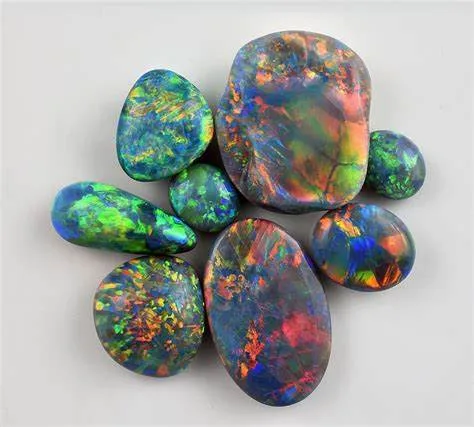
Famous opals, notable discoveries, and opal-adorned jewelry pieces have captured the fascination of people around the world for their exquisite beauty and unique play of color. Here are some notable examples:
Famous Opals:
- Aurora Australis: The Aurora Australis is one of the world’s most famous black opals. Discovered in Lightning Ridge, New South Wales, Australia, in 1938, it is renowned for its intense play of color, including vivid reds and blues. It weighs approximately 180 carats and is considered one of the most valuable opals in existence.
- Andamooka Opal: Found in South Australia in 1932, the Andamooka Opal is another legendary black opal. It displayed remarkable play of color and weighed over 200 carats in its rough state. It was later cut into several smaller stones, with the largest known as the “Queen’s Opal.”
- The Olympic Australis: Discovered in 1956, the Olympic Australis is one of the largest and most valuable opals ever found. It weighs around 17,000 carats and was named in honor of the 1956 Olympic Games held in Melbourne, Australia. Its play of color is exceptional, featuring a wide spectrum of hues.
Notable Opal Discoveries:
- Lightning Ridge, Australia: Lightning Ridge, located in New South Wales, is renowned for its black opals. The town’s opal fields have yielded many exceptional gems, including the world-famous Aurora Australis and Andamooka Opal.
- Coober Pedy, Australia: Coober Pedy is another major opal mining area in South Australia. It is known for producing white opals and crystal opals, often used in high-quality jewelry.
- Welo, Ethiopia: In recent years, Ethiopia has emerged as a significant opal-producing region. The Welo opal fields have yielded vibrant and colorful opals, including precious and crystal opals.
- Virgin Valley, Nevada, USA: Nevada is known for producing valuable black and fire opals. Virgin Valley, in particular, has been a source of stunning opals, including the Rainbow Ridge Opal and the Bonanza Opal.
Famous Opal Jewelry Pieces:
- The Burning of Troy Tiara: This exquisite tiara, made by Castellani in the 19th century, features opals among other gemstones. It is a part of the British royal collection and is known for its intricate design and historical significance.
- The Empress Eugénie Tiara: Commissioned by Emperor Napoleon III of France for his wife, Empress Eugénie, this tiara features opals and diamonds in a delicate floral motif. It remains one of the most famous opal tiaras in history.
- The Grand Opal Tiara: Created by Boucheron for Queen Isabella II of Spain, this tiara features several opals surrounded by diamonds. It is now part of the Spanish royal jewelry collection.
- The Queen’s Opal Brooch: The largest stone cut from the Andamooka Opal, known as the “Queen’s Opal,” was set into a brooch and presented to Queen Elizabeth II of the United Kingdom during her visit to Australia in 1954.
These famous opals and opal-adorned jewelry pieces showcase the allure and beauty of these gemstones, which have captivated the hearts of collectors, royalty, and jewelry enthusiasts throughout history. Opals continue to be treasured for their enchanting play of color and timeless appeal.
Conclusion
In summary, opals are captivating gemstones known for their unique play of color, formed through the interaction of silica-rich solutions with specific geological conditions. They have significant historical, cultural, and symbolic importance and are used in various applications, primarily in jewelry and ornamental items. Notable opals, such as the Aurora Australis and the Olympic Australis, have achieved worldwide fame, and opal discoveries in places like Lightning Ridge and Coober Pedy, Australia, have shaped the opal industry.
Key Points:
- Opals are composed of hydrated silica and have an amorphous structure.
- They exhibit a play of color or opalescence due to the diffraction and interference of light with microscopic silica spheres.
- Opals come in various types, including precious opals (e.g., white, black, crystal, boulder) and common opals (e.g., white common, Mexican fire).
- Opals are used in jewelry, art, collectibles, religious items, and more.
- Famous opals like the Aurora Australis and the Olympic Australis are highly valuable and renowned for their beauty.
- Notable opal discoveries have been made in Lightning Ridge and Coober Pedy, Australia, as well as in Ethiopia and the United States.
- Opals have adorned famous jewelry pieces, including tiaras and brooches, and have historical and royal significance.
Future of Opals:
The future of opals is promising but also faces challenges:
- Sustainability: Ethical and sustainable sourcing of opals will likely become increasingly important as consumers prioritize responsible practices in the gemstone industry.
- Technology: Advancements in gemstone treatment and enhancement techniques may impact the opal market. Disclosure and transparency in gemstone treatment will be critical.
- Fashion Trends: Opals are likely to continue to be sought after for their unique play of color and artistic appeal, especially in custom and artisan jewelry pieces.
- Scientific Research: Ongoing research into the geological processes and formation of opals can provide valuable insights and may lead to new discoveries.
In conclusion, opals will remain a beloved gemstone for their enchanting beauty and symbolic significance. Their future will be shaped by evolving consumer preferences, sustainable practices, and ongoing scientific exploration.
References
- Bonewitz, R. (2012). Rocks and minerals. 2nd ed. London: DK Publishing.
- Mindat.org. (2019). Opal: Mineral information, data and localities.. [online] Available at: https://www.mindat.org/ [Accessed. 2019].
- Wikipedia contributors. (2019, June 13). Opal. In Wikipedia, The Free Encyclopedia. Retrieved 00:37, June 20, 2019, from https://en.wikipedia.org/w/index.php?title=Opal&oldid=901668208




































